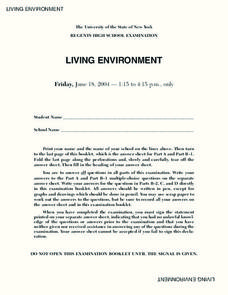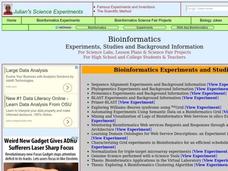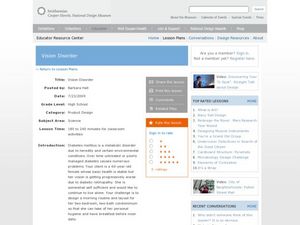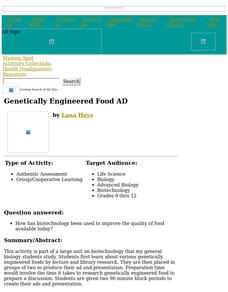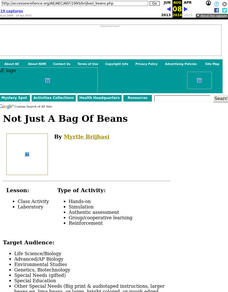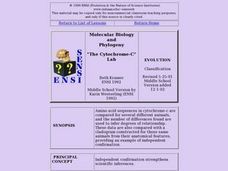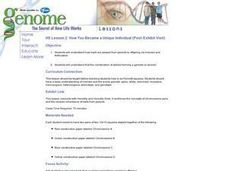Curated OER
What's For Dinner?
Students share their own views on eating genetically altered foods. After reading an article, they research any issues concerning these types of foods in the United States. In groups, they create a campaign slogan to help gain funding...
The Science Spot
Bikini Bottom Genetics 2
In this biology worksheet, students use the information given on genetics, Sponge Bob and other characters to complete each of the questions on the sheet. They write the phenotype for each stated trait. Students also determine the...
Curated OER
Human Genetics-- Thinking About Similarities And Differences
In this science worksheet, students investigate the differences in genetic traits of eyes, hair color and texture. Students answer 3 questions about themselves and draw a picture of their head.
Curated OER
From DNA to Protein
In this DNA activity, students will compare the chemical differences between DNA and RNA. Students will review what makes up the genetic code and the steps of transcription from DNA to mRNA to proteins. This activity has 26 fill in the...
Curated OER
Control of the Cell Cycle
In this cell cycle activity, students review how enzymes control the cell cycle and what happens when the cell cycle becomes uncontrolled. This activity has 7 short answer questions.
Curated OER
Codons
In this codon worksheet, students use a table showing codons in mRNA to determine how mutations will affect amino acid sequences. This worksheet has 4 fill in the blank and 2 short answer questions.
Curated OER
Examining the Fossil Record
Students create an evolutionary tree based on fossil morphology and their ages. In this fossil record lesson plan, students are given 23 pictures of fossil. They study their morphology and arrange the fossils by age and structures on a...
Curated OER
Who Ate The Cheese?!
In this crime scene investigation worksheet, students simulate DNA sequencing and DNA restriction analysis using paper strips of DNA. Students compare the crime scene DNA to the suspects and determine who is guilty.
Curated OER
Heredity Worksheet: Dihybrid Cross
In this genetics worksheet, students use a Punnett square to determine the genotypes and phenotypes of the offspring of a dihybrid cross. Then students complete 10 fill in the blank questions.
Curated OER
Living Environment
In this environmental worksheet students complete a series of multiple choice and short answer questions on cell types, cell division, chromosomes and plant species.
Curated OER
Evolution
In this evolution worksheet learners complete a crossword puzzle by answering questions about the environment, evolution and populations.
Curated OER
Breaking News English: Waterproof Genetically-Modified Rice
In this waterproof genetically modified rice activity, students read the article, answer true and false questions, complete synonym matching, complete phrase matching, complete a gap fill, answer short answer questions, answer discussion...
Curated OER
Creating the "Perfect" Horse
Students examine the relationship between a horse and its rider. In this behavior and interactions lesson students research the Internet to learn about horse behavior and biology then write a paper and present it to the class.
Curated OER
Bioinformatics
Students conduct a series of scientific investigation using bioinformatics. For this molecular biology lesson, students collect experimental data using different educational softwares. They calculate and analyze relationships using...
Curated OER
Vision Disorder
Students design a morning routine for a 60 year old female senior with vision disorder. In this biology lesson, students collaborate with their team to come up with possible solutions. They present at least two ideas of their design to...
Curated OER
Genetically Engineered Food AD
Students examine various genetically engineered foods by lecture and library research. They are then placed in groups of two to produce their ad and make a presentation on a food they have developed.
Curated OER
Not Just a Bag of Beans
Students determine the types of natural selection and variation that exists in a population, using beans.
Curated OER
Genetics the Easy Way
Learners use recyclable trash to construct a Recycle Critter family. They calculate the probability of the phenotype of the offspring that two heterozygous parents produced.
Curated OER
The Empirical Challenges of Racial Classification
This lesson will help students examine their preconceptions and assumptions about racial categories and understand the impossibility of constructing a consistent system of human racial classification.
Curated OER
The Cytochrome-C Lab
Students examine a method biologists use to try to determine relationships. They examine how amino acid sequences have been determined for a number of proteins, and how scientists can make inferences about DNA based on the amino acid...
Curated OER
The Structure of DNA
Students describe the structure of the double helix, explain how DNA copies itself, and recognize that the sequence of DNA is what makes each individual unique.
Curated OER
How You Become a Unique Individual
Students investigate how traits are passed from parents to offspring via meiosis and fertilization. They recognize that the combination of alleles forming a gamete is random.
Curated OER
And the Verdict Is...
Young scholars identify the unique pattern DNA forms in each individual, and how that pattern can be used to identify criminals. They have the opportunity to simulate the process of matching DNA samples to those taken at a crime scene.
Curated OER
Sun and Skin
Students work in small groups researching different aspects of the sun and skin. The groups summarize and answer questions about the material in a presentation to the class.
Other popular searches
- Dominant Genes
- Dominant and Recessive Genes
- Recessive Genes
- Genes and Heredity
- Chromosomes and Genes
- Genesis
- Dna, Genes & Chromosomes
- Dominate and Recessive Genes
- Traits and Genes
- Ethnicity Genes
- Color Genes
- Genes Alleles











